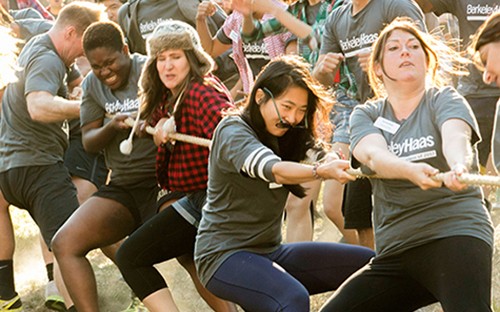Maura Herson has said that business schools have moved on from being male-dominated institutions churning out competitive “would-be wolves of Wall Street”.
But, writing in BusinessBecause on Thursday, Maura, who oversees the top-five US MBA, highlighted the worrying lack of women in the applicant pool, with the figure lingering between 34% and 39% for much of the past decade.
She compared this with other professional degrees, saying women comprise roughly half of all law and medical school students, “but this is not the case on business school campuses”.
The drive to get more women into management education was given added impetus this year after 40 top US business schools, including Stanford, Yale and Columbia entered a pact at the White House to do more to diversify their MBA programs.
Enrolling more women is widely viewed as a factor in closing the gaping gender divide in the top ranks of business. A recent survey from McKinsey & Company, the consultancy, and LeanIn.Org found women make up just 17% of the executive suite. Research this year by the Graduate Management Admissions Council shows that in the US, women make up only 21% of senior management positions.
Elissa Sangster, executive director of Forté Foundation, which helps women launch business careers, said: “Continuing to see a larger percentage of women enrolled [in business school] is important for future leadership around the globe.”
But Alixandra Pollack, a research director at Catalyst, which promotes women in business, said that driving change from the top is “absolutely critical”: “Senior leaders are essential to spark change, drive the vision, and ensure accountability,” she said.
In 2005, women comprised 29% of the student body at top schools, according to Forté Foundation. But that gap has begun to widen — largely due to schools’ ramping up of efforts to target women, such as the Gender Initiative at Harvard Business School, which 50 years ago had not admitted a single woman into its MBA.
At Wharton and Kellogg, two top US schools, the MBA classes this year are comprised of 43% women. At Tuck School and Stanford, women amount to 42% of the class. For Berkeley’s Haas School, the figure is 41%.
However, many thought leaders said schools have much further to go in boosting the number of women in their MBA programs.
Susan Vinnicombe, professor of women and leadership at Cranfield School of Management, who leads FTSE 100 board research, told BusinessBecause that schools must market their programs better to women and introduce more incentives to attend, such as bursaries.
Dianne Bevelander, executive director of the Erasmus Centre for Women and Organizations at Rotterdam School of Management, said that addressing the gender challenge will take more than simply recruiting more women.
“Our academic and administrative leadership too often mirrors business in being overwhelmingly male-dominated,” she said.
Maura at MIT Sloan, which enrolled a record 41% women this year, said that times have changed: “Business schools are now much more supportive of women in the classroom and elsewhere.”
But she added: “The message to young women is loud and clear: we need you."
RECAPTHA :
ae
ea
83
8a








![Social entrepreneurship at the Asia School of Business means sharing and learning from business experts [draft copy]](/uploads/default/news/images/thumbnail_bd033d2d31684d24ec798e9193783eb8fde28ec6.png)